英国高等教育发展共66页文档
- 格式:ppt
- 大小:6.05 MB
- 文档页数:66
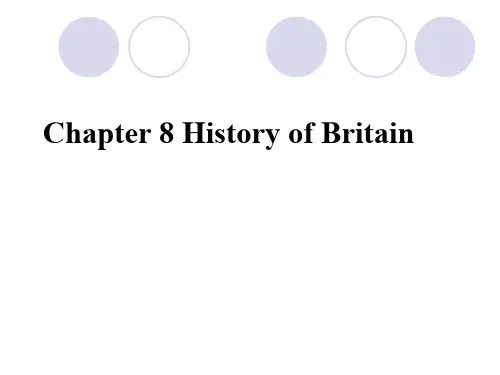
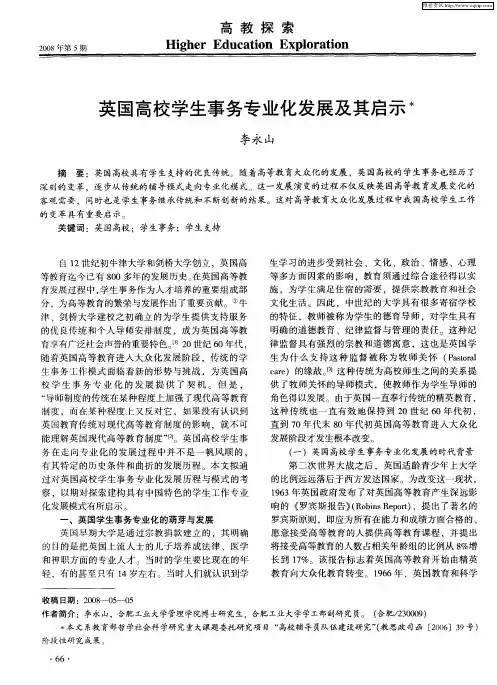

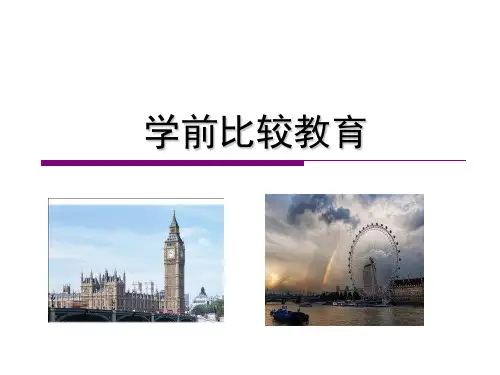
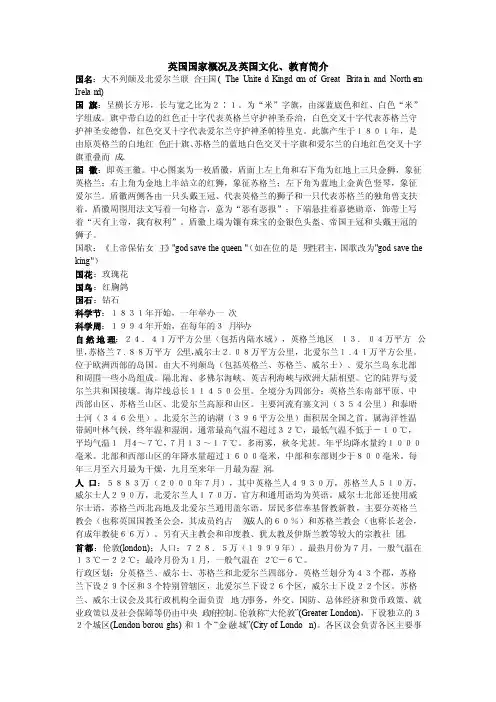
英国国家概况及英国文化、教育简介国名:大不列颠及北爱尔兰联合王国 ( The United Kingdo m of GreatB ritai n and Northe rn Irelan d)国旗:呈横长方形,长与宽之比为2∶1。
为“米”字旗,由深蓝底色和红、白色“米”字组成。
旗中带白边的红色正十字代表英格兰守护神圣乔治,白色交叉十字代表苏格兰守护神圣安德鲁,红色交叉十字代表爱尔兰守护神圣帕特里克。
此旗产生于1801年,是由原英格兰的白地红色正十旗、苏格兰的蓝地白色交叉十字旗和爱尔兰的白地红色交叉十字旗重叠而成。
国徽:即英王徽。
中心图案为一枚盾徽,盾面上左上角和右下角为红地上三只金狮,象征英格兰;右上角为金地上半站立的红狮,象征苏格兰;左下角为蓝地上金黄色竖琴,象征爱尔兰。
盾徽两侧各由一只头戴王冠、代表英格兰的狮子和一只代表苏格兰的独角兽支扶着。
盾徽周围用法文写着一句格言,意为“恶有恶报”;下端悬挂着嘉德勋章,饰带上写着“天有上帝,我有权利”。
盾徽上端为镶有珠宝的金银色头盔、帝国王冠和头戴王冠的狮子。
国歌:《上帝保佑女王》 "god save the queen"(如在位的是男性君主,国歌改为"god save the king")国花:玫瑰花国鸟:红胸鸽国石:钻石科学节:1831年开始,一年举办一次科学周:1994年开始,在每年的3月举办自然地理:24.41万平方公里(包括内陆水域),英格兰地区13.04万平方公里,苏格兰7. 88万平方公里,威尔士2. 08万平方公里,北爱尔兰1. 41万平方公里。
位于欧洲西部的岛国。
由大不列颠岛(包括英格兰、苏格兰、威尔士)、爱尔兰岛东北部和周围一些小岛组成。
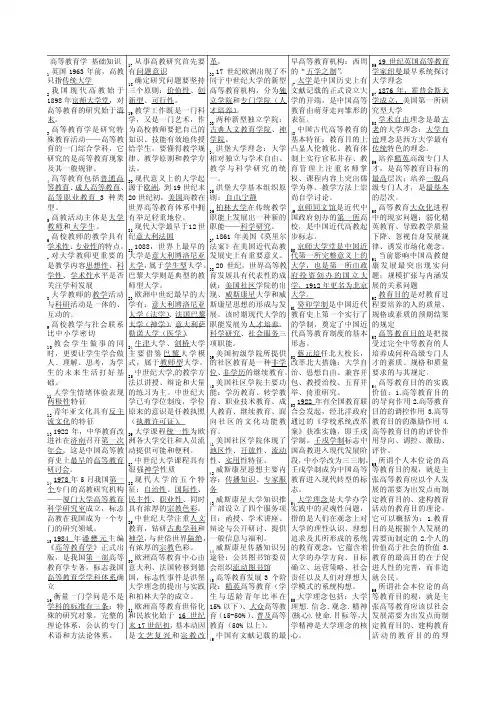
高等教育学 基础知识1 英国1963年前,高教只指传统大学2 我国现代高教始于1898年京师大学堂,对高等教育的研究始于清末。
3 高等教育学是研究特殊教育活动——高等教育的一门综合学科,它研究的是高等教育现象及其一般规律。
4 高等教育包括普通高等教育、成人高等教育、高等职业教育3种类型。
5 高教活动主体是大学教师和大学生。
6 高校教师的教学具有学术性、专业性的特点。
7 对大学教师更重要的是教学内容思想性、科学性、学术性水平是否关注学科发展8 大学教师的教学活动与科研活动是一体的、互动的。
9 高校教学与社会联系比中小学密切10教会学生做事的同时,更要让学生学会做人、理解、思考,为学生的未来生活打好基础。
11 大学生情绪体验表现两极性特征12 青年亚文化具有反主流文化的特征13 1922年,中华教育改进社在济南召开第一次年会,这是中国高等教育史上最早的高等教育研讨会。
14 1978年5月我国第一个专门的高教研究机构——厦门大学高等教育科学研究室成立,标志高教在我国成为一个专门的研究领域。
15 1984年潘懋元主编《高等教育学》正式出版,是我国第一部高等教育学专著,标志我国高等教育学学科体系确立16 衡量一门学问是不是学科的标准有三条:特殊的研究对象,完整的理论体系,公认的专门术语和方法论体系。
17从事高教研究首先要有问题意识18确定研究问题要坚持三个原则:价值性、创新型、可行性。
19教学工作既是一门科学,又是一门艺术,作为高校教师要把自己的知识、技能有效地传授给学生,要懂得教学规律、教学原则和教学方法。
20现代意义上的大学起源于欧洲,到19世纪末20世纪初,美国高教在世界高等教育体系中拥有举足轻重地位。
21现代大学最早于12世纪意大利法国221088,世界上最早的大学是意大利博洛尼亚大学,属于学生型大学。
巴黎大学则是典型的教师型大学。
23欧洲中世纪最早的大学有:意大利博洛尼亚大学(法学)、法国巴黎大学(神学)、意大利萨勒诺大学(医学)。
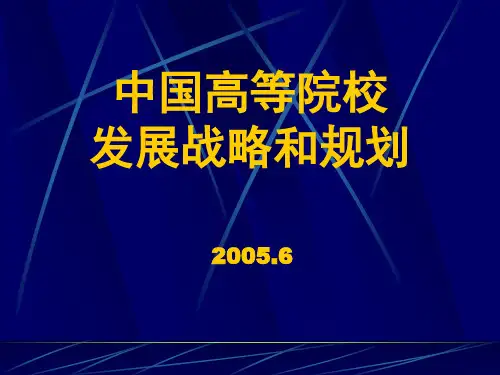

2021年第5期高教探索Higher Education Exploration英国政府高等教育行政机构的演变冯磊摘要:缘于深厚的大学自治传统,英国政府高等教育行政机构经历了从“惰性政治”到“绅士政治” 再到“利益政治”的缓慢而独特的演变历程。
在这一过程中,英国高校无法满足时代需求一直是引发高等教 育行政机构重大转折的关键原因。
随着时代转折,英国高等教育行政机构设置越来越专业化,行政授权越来越 明晰化,权力运行刚性不断增强,行政决策从依靠学术人员到依赖牛桥精英圈的私人关系网络再到由政府各部 门复杂利益网络驱动,而学术人员影响力不断减弱,引发我们对当代高等教育治理的深思。
关键词:高等教育治理;行政机构;历史演变;制度变迁;英国高等教育治理离不开政府参与,政府高等教育 行政机构的发展决定了整个高等教育治理模式的演 化。
[1]英国一直有其独特的高等教育治理模式,为世 界贡献了诸多高等教育治理经验,其高等教育治理 模式的发展同样与政府高等教育行政机构的演变联 系密切。
英国大学自治传统深厚,长期警惕政府行 政介入,因而政府高等教育行政机构的发展极为缓 慢,形成了独特的演变历程。
推进政府高等教育行 政机构、职能、权限、程序、责任法定化是完善国 家行政体制的必然要求,也是建设高等教育强国的 重要基础。
本文意在通过分析英国政府高等教育行 政机构的演变,为我国推进高等教育行政机构设置 更加科学、职能更加优化、权责更加协同提供更多 实践参考。
政府在某一公共领域的行政机构设置及其运行 规则塑造了政府在该领域事务中决策活动的形态,构成了该领域的政治基本要素。
[2]本文根据英国政府 高等教育行政机构设置及其运行规则的典型特征变 化,将其演变过程分为惰性政治、绅士政治和利益 政治三个时代。
为了揭示演变过程,本文将解决以 下三方面问题:第一,针对每个时代,探讨是怎样 的社会背景变化引起怎样的新冲突,继而引发英国 政府高等教育行政机构的重大调整。
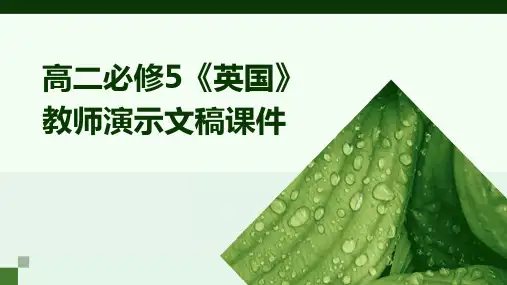
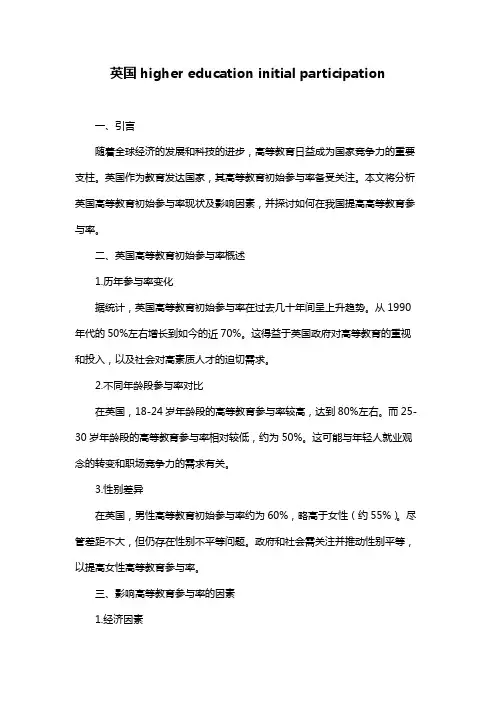
英国higher education initial participation一、引言随着全球经济的发展和科技的进步,高等教育日益成为国家竞争力的重要支柱。
英国作为教育发达国家,其高等教育初始参与率备受关注。
本文将分析英国高等教育初始参与率现状及影响因素,并探讨如何在我国提高高等教育参与率。
二、英国高等教育初始参与率概述1.历年参与率变化据统计,英国高等教育初始参与率在过去几十年间呈上升趋势。
从1990年代的50%左右增长到如今的近70%。
这得益于英国政府对高等教育的重视和投入,以及社会对高素质人才的迫切需求。
2.不同年龄段参与率对比在英国,18-24岁年龄段的高等教育参与率较高,达到80%左右。
而25-30岁年龄段的高等教育参与率相对较低,约为50%。
这可能与年轻人就业观念的转变和职场竞争力的需求有关。
3.性别差异在英国,男性高等教育初始参与率约为60%,略高于女性(约55%)。
尽管差距不大,但仍存在性别不平等问题。
政府和社会需关注并推动性别平等,以提高女性高等教育参与率。
三、影响高等教育参与率的因素1.经济因素经济因素是影响高等教育参与率的关键因素。
在英国,家庭经济状况较好的学生更容易接受高等教育。
政府可通过奖学金、助学金等政策,降低贫困家庭学生的入学门槛。
2.社会文化因素英国社会文化氛围鼓励人们追求高等教育,有利于提高参与率。
此外,社会对高等教育的认可度也促使更多人投身于高等教育。
3.政策因素英国政府对高等教育的投入和支持力度不断加大,例如提高公立大学学费补贴、扩大招生规模等。
这些政策有利于提高高等教育初始参与率。
四、我国高等教育参与现状及挑战1.参与率增长趋势近年来,我国高等教育参与率逐年上升,已突破40%。
但与英国等发达国家相比,仍有较大差距。
2.城乡差距我国城乡高等教育参与率存在较大差距。
城市高等教育参与率较高,而农村较低。
政府需加大对农村教育资源的投入,提高农村学生的高等教育机会。
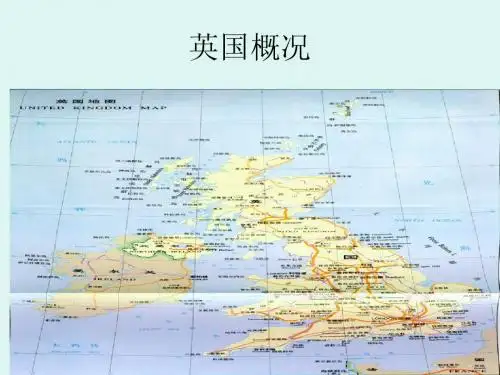
英国阅读教育历史发展英国的阅读教育历史发展可以追溯到中世纪。
在那个时期,阅读技能被视为高贵和特权的象征,只有少数人能够获取。
主要的受教育者是贵族和教会官员,他们通过学习拉丁语和希腊语来获得阅读能力。
然而,随着时间的推移,英国社会逐渐意识到普及阅读教育的重要性。
在16世纪的宗教改革中,教会开始推动普通民众学会阅读圣经,以便个人能够直接阅读并理解上帝的话语。
这一时期的阅读教育主要集中在宗教文本上。
到了18世纪,英国的工业革命带来了社会变革,阅读教育也开始朝着更广泛的方向发展。
工人阶级的兴起和普通人对知识的渴望促使政府采取了一系列措施来推动普及教育。
1811年,英国成立了第一个国家教育协会,为普通人提供了免费的阅读教育。
19世纪是英国阅读教育发展的关键时期。
教育法案的颁布使得教育成为了每个孩子的权利。
学校开始普及,在教育课程中加入了阅读和写作的训练。
同时,图书馆的建立也为人们提供了更广泛的阅读资源。
20世纪以来,英国的阅读教育进一步发展。
学校图书馆的建设和阅读计划的推出使得阅读成为学生学习的重要组成部分。
此外,英国政府还积极推动家庭阅读计划,鼓励家长和孩子一起分享阅读的乐趣。
尽管英国的阅读教育历史发展经历了不同的阶段,但其核心目标一直保持不变:提供给每个人获取知识和理解世界的机会。
阅读教育不仅仅是学习字母和单词,更是培养思维能力、扩展视野和增强创造力的过程。
英国的阅读教育历史发展经历了从特权到普及的转变,从宗教到广泛知识的拓展。
这一过程不仅改变了英国社会,也为每个人提供了发展的机会。
阅读教育的重要性在今天依然不可忽视,它是培养未来领导者和创造者的关键。
英国教育Education in the United Kingdom is a devolved matter with each of the countries of the United Kingdom having separate systems under separate governments.i.e. Educational System in EnglandEducational System in WalesEducational System in N. IrelandEducational System in ScotlandThe Present Educational System*Pre-Primary Education(3-5)*Primary Education(5-11)Compulsory Education(5-16)*Secondary Education(11-16)Compulsory Education(5-16)*Further Education(16-18)*Higher Education(18+)Pre-Primary Education(3-5)学期教育*Institutions: Nursery Schools/Kindergartens*NOT compulsory*Be available for kids from age 3-5 through playgroups and nursery schools (many are on a fee-paying basis).*The emphasis is on group work, creative activity and guided play.Two Systems of primary and secondary education in Britain:1.State Schools (公立学校):11-year Compulsory Education (5-16)State Primary School →Secondary Education(94%)2.Public Schools/ Independent/Private Schools (独立学校/公学):Prep School → Public (Independent) School (6%)What are the difference between the Two?State(Maintained)schools:*funded by local and central governments.*Attendance:94%*co-educational day schools*comparatively new, a means of extending education to the common people.*imitating the public schools in some ways but generally inferior to them.Public schools=Independent schools:*Tuition fees; Endowments (捐赠) or donations from society (esp. alumni to their alma maters)*Attendance: 6%*Boy’s or Girl’s; usu. Boarding*originally created to provide education for the sons of the rich and aristocratic*Public schools have better teaching staff & facilities.*Students from the public schools are more promising, e.g. Eton College伊顿公学has educated 20 Prime Ministers, 6 Chancellors of Exchequers, etc.What are the difference between the Two?*various forms of state secondary schools*Cradles for Oxbridge and good profession, Higher social positions, etc.State-School Style of primary(5-11) and secondary education(11-18) in Britain:*The Features*Primary Education*Secondary EducationCompulsory education begins at 5 until 16 in England, Wales and Northern Ireland. (11 years in total).The Features1.The importance of compulsory education(5-16)*Formal education plays a social and cultural role in socializing children (Purpose).*It signifies the development of education.*It shapes people’s social life and status.2. Education by Law*Full-time education is compulsory for all children aged between 5 and 16(inclusive) across England (11 years in total).*This can be provided by state schools(free-94%), independent schools (Public/Private schools), or homeschooling.3. Curriculum*All government-run schools, state schools, follow the same National Curriculum, which was introduced into England, Wales and Northern Ireland as a nationwide curriculum for primary and secondary state schools following the Education Reform Act 1988.The National Curriculum•English•Science•Mathematics•Physical Education•Information & Communication Technology•Music•Geography•Art•Design & Technology•History•Modern Foreign Language•Citizenship•Work-related Learning4. The School Year学年*The academic year in UK has three terms. Each term will run for seven to fourteen weeks--from September to July. School holidays are Christmas, Easter and summer vocation (July to Sep)—9-12; 1-4; 5-7mon.The primary / secondary schools and further education colleges normally have a much longer term than those adopted by the Universities.*The school hours of attendance commonly: 9:00—12:00; 14:00—16:00Primary Education (5-11)初等教育* Pupils mainly (94%) attend state sector primary schools: compulsory--co-educational or mixed schools.*The State primary institutions including: “Infants schools幼儿学校(5-7)” = First Schools“Junior schools初级学校/小学(7-11)”*Year 1 to Year 6*There’s littl e or no specialist subject teaching and great emphasis is on literacy and numeracy in early years.☆Secondary Education (11-18)中等教育Secondary Education(11-16)--Year 7-Year 11※State Secondary Schools(11-16)1. Grammar Schools文法中学(3%)2. Secondary Modern Schools现代中学or Technical schools技校(7%)3. Comprehensive Schools综合中学(84%)*Grammar Schools文法中学(3%)Grammar schools select children through an examination called “the 11-plus”(preparing students for higher education)--选拔优秀小学生毕业考试.What is the “11-plus”?♂It is an old selective system优选制, children take an examination ,called the “eleven plus” in their last year at primary school.♂The results of this examination determine the kind of secondary schooling each child will receive.*Those with the highest marks go to grammar schools(3%), which lay emphasis on advanced academic subjects rather than the more general curriculum of the comprehensive schools and expect many of their pupils to go on to universities.*Other children may go to technical schools技校and the rest go to secondary modern schools现代中学.(7%)*Comprehensive Schools综合中学(84%)--Overcome the inequality of 11-plus--In the 1960s, Comprehensive schools were introduced all over the country and are the most popular secondary schools in Britain today.--No entrance exam, a means of extending education to the common people--General education/non-selective and open to pupils of all abilitiesWhat is a comprehensive school like?*About 25 pupils/class*Practical Subjects: French (German or Spanish), physics, chemistry, biology, economics, shorthand, drama, cooking, gardening or flower-arrangement, filming, etc.Exams•Compulsory education ends at age 16.•At 16, students take GCSE examination.*GCSE― General Certificate of Secondary Education(普通中等教育证书/中学毕业证书) after 5 years of secondary education.*Today, letter grades are used for GCSE with A+, A, B, C, D, E, F representing a pass and G representing a fail.GCSEGrade A+/A A good result of exceptional qualityGrade B / C The higher grades needed for further and higher educationGrade D / E Regarded as average grades-a good base from which to growGrade F The lower, but still useful, grades of achievementGrade G Unfortunately, no score*Further Education(16-18)延续教育--a term mainly used in connection with education in the United Kingdom and Ireland.--Known as “Tertiary Education”第三级教育for two years—”Year 12, and 13”.--About 600 colleges/schools of Further Education institution (state-run ones are free) --most of further education are provided by Colleges of Further Education, colleges of techonology, technical colleges; some are offered at universities or a six form college of a secondary school.--It is post-compulsory education, that is distinct from the education offered in universities (higher education). It may be at any level above compulsory secondary education, from basic skills training to higher vocational education.-- Based on the results of the GCSE, they will decide what avenue of education they would like to follow:@Academic Route学业路线@Vocational Route职业路线@Academic Route学业路线It is usually chosen by some more ambitious and hardworking students preparing for a university. They will take GCE O-level (一般水平普通教育证书) exams. If they pass, they may transfer to a school of Further Education to learn GCE A-Level classes for 2 years.At 18, they take GCE A-level examinations usually in 3(or 4) subjects. in order to go to a university or other institutions of higher education.What are A-levels exams?•General Certificate of Education-Advanced “普通教育高级证书=大学入学考试/高考”.•For Pupils who hope to attend university carry on their academic study.•Usually taking place in a school of further Education (For example, Sixth Form school 六年级学校or tertiary college三级学校—Further Education College).•Most pupils try to achieve 3 or 4 A-levels in the subjects they are most proficient at. (Stressful)@Vocational Route职业路线•Other pupils who decide not to go to university may choose to sit the GNVQ (General National Vocational Qualification 国家专业资格证书) for vocational training or preparing for work.Independent Style of primary(5-11) and secondary education(11-18) in Britain:In the UK private schools are confusingly called public schools! (6% of the total school population)*School Systems of Independent Schools:--Primary Education:”Prep School” 预备学校at 7/8--Secondary Edu.: At 13-18, Public School公学through “Common Entrance” Exam*High tuition fees + large quantity of social endowments = affording smaller classes + better faculty (with nice salaries)*not part of the national education system.*Mainly s ingle-sex rather than co-ed schools.*Boarding schools.Question: Who are attending such schools?•The students are largely from aristocratic (贵族) and upper class families; and they are more expected to Oxbridge.•BUT opponents voice doubts:It’s socially divisive and breeds elitism; they are offering more promising opportunities to 6% of British children, but it’s unfair for the remaining 94%!The Most Well-known Public Schools:•Eton College (伊顿公学) (1440 by King Henry VI)•Harrow School (哈罗公学) (1571) (Byron, Churchill)•Winchester College (温切斯特公学) (1394)•Rugby School (拉格贝公学) (1567) (Rugby was first played here.)Eton College伊顿公学•For boys ONLY!•Its students are from noble and upper class families. (Prince Charles, William & Harry)•So far, about 20 PMs were educated at Eton. "the chief nurse of England's statesmen" "No other school can claim to have sent forth such a cohort of distinguished figures to make their mark on the world."•The school fee includes tuition, board & lodging, laundry, personal accident insurance, and the cost of most activities.•How much is the school fee at Eton?An annual fee of about £26,490.Higher Education(18+)高等教育⊙Formal Universities*Introduction*Categories*Entrance Procedure*Teaching Methods*Degrees and Features⊙Open University*Introduction•All British universities are self-governing and fee-charging. They receive financial aid through the University Grants Committee (高校基金委员会) from the government.•Over 42% of pupils become university students on leaving school at 18.•Fee-charging (on the average: £1200-3000)*Categories•110 universities or institutions of Higher Education in UK (93 in England, 13 in Scotland, 2 in Wales and 2 in N.Ireland)• 3 categories:--Old universities--Redbrick universities (1800-1950s), --New universities (1960s- present).Old Universities(12th—19th Centuries)Oxford and Cambridge, dating from the 12th and 13th century(Oxbridge, for man only until 19th)4 Scottish University dating from the 15th-16th:St. Andrews, Glasgow, Edinburgh and Aberdeen3 others from the 19th. Durham; London; WalesRedbrick universities (1800-1950s)The term “red brick” or “redbrick” was first coined by a professor of Spanish (Edgar Allis on Peers) at the University of Liverpool to describe the civic universities市立大学which featured with The Victoria Building built from a distinctive red pressed brick, with terracotta赤土decorative dressings.Eg. Manchester; Sheffield; Exeter; Leeds; Birmingham; Southampton; Loverpool; Nottingham; Leicester; Bristol;Reading; Hull. Keele; Lancaster; York; East Anglia; Sussex; Newcastle; Essex; Warwick; Dundee; Kent.New universities (1960s- present)It came to be used to refer to any of the universities founded in and after the 1960s.•Anglia Ruskin University– formerly Anglia Higher Education College, Anglia Polytechnic then Anglia Polytechnic理工类University•Birmingham City University– formerly the University of Central England in Birmingham and before that, Birmingham Polytechnic•University of Brighton– formerly Brighton Polytechnic•… … … … …Entrance Procedures•In the third term of Year 12, students prepare their applications to university.•Applications are then made in the first term of the Year 13 through one centralized organization known as UCAS (Universities and Colleges Admissions Service大学院校入学委员会).•Students can apply to a maximum of 6 universities/institutions.•Admission – selection on basis of A-level results & an interview.Teaching Methods•The UK educational system encourages self-study, discussions and practical work. The students may havetime-tabled classes or might be encouraged to do more of independent work for a substantial amount of time depending on the course.•Most of the courses would include the following teaching methods:A.Lectures 讲座The professors dominate the lectures which serve to guide the students.The size of the class is generally large, often up to 100 students.NO prescribed textbooks but reading lists and handouts (讲稿)!B.Seminars 讨论会*The seminars provide the students with a platform for sharing their views on a given topic.*The students are told in advance about a topic & are required to prepare a presentation on it.*What is the point of attending seminars?The discussions that take place in seminars often help students understand a topic better in different perspectives and help students develop their communication skills.C.Tutorials 导师辅导课•T utorials give you focused guidance on a particular topic once a week.•T he size of tutorials is quite small. (15-20) Every student has to speak in class.•T he students meet with the professors individually to discuss their concerns about the topic that they have undertaken and thus seek individual guidance.D.Independent work*Students are supposed to investigate a topic in detail and develop their own views about it. (off-campus research)*This usually involves working individually or in a small group with other students to research a topic.*Produce written work or make presentation for a seminar.E. Coursework 课程论文/学年作业•This may include essays, reports, projects, presentations or reflections.•Coursework is assessed and given grades.•Assessment: a combination of methodsPlagiarism 剽窃*Plagiarism means presenting other people’s work as one's own without acknowledging the source or referencing.*Cheating or plagiarism can result in students not being allowed to graduate.*Advice is normally given by your professors on an acceptable way and amount of referencing. (footnote/bibliography) Degrees---How long to take?★BA/BSc: 3 years full-timeExceptions: Medical; Law—as 5-year undergraduate degrees.★MA/MSc: 1 year full-time*Usually taking only 1 year. But it also depends:*A taught master’s degree授课式的硕士课程—1 year*A research master’s研究式的硕士—2years*Master by Research (M.Phil- Master of Philosophy)写研究论文取得的硕士–1-2years★PhD at least 3 years original research*BA: Bachelor of Arts (文学学士)*BSc/BS: Bachelor of Science (理学学士)*PhD ( Doctor of Phil osophy) is written after someone’s name to indicate that he has a PhD: Collins, PhD.Features of Universities1. College system—self-governing. The value of this lies in fostering a community spirit in which a useful mingling of intelligence can take place.2. Three-term academic year—from Sep. or Oct. to June or July; three terms of 8-10 weeks; academic terms are different in each university and each year. Eg., (2011-2012)Ox—”Michaelmas”(10.9-12.3)、“Hilary(1.15-3.10)”、“Trinity(4.22-6.16)”—three termsCam--“Michaelmas”(10.4-12.2)、“Lent(1.17-3.16)”、“Easter(4.24-6.15)”UCL—”the first, second and third” term: 9.26-12.16; 1.9-3.23; 4.23-6.83. Courses may be full-time, part-time or sandwich(工读交替制)5. Students are awarded first-, second-, and third-class honours according to the results of the final examinations at the end of the third year of study or and the assessments over the period of study.Higher Education: Open universities函授大学、开放大学•Opened in 1969 and was intended to give opportunities to adults who had been unable to take traditional higher education.•It is open to everybody and does demand formal qualifications.•Lectures are broadcast on television and radio, and students correspond with their tutors by post.•At the end, successful students are awarded a university degree.2008《TIMES》英国大学排名排名英文校名中文校名1Oxford牛津大学2Cambridge 剑桥大学3Imperial College帝国理工学院4London School of Economics 伦敦政经学院5St Andrews 圣安德鲁斯大学6University College London 伦敦大学学院7Warwick华威大学8Bristol布里斯托大学9Durham杜伦大学10King’s College London伦敦国王学院两校的对比•长久以来,牛津大学和剑桥大学差别并不大。
欧洲高等教育的发展历史
中世纪:欧洲高等教育的起源可以追溯到11世纪的巴黎圣母院学院,随后逐渐发展成为一种独特的教育体系。
近代化阶段:从19世纪到20世纪,欧洲的大学经历了极大转型。
这一阶段的改革主要包括行业化和国际化、民族化和世俗化以及制度化等。
现代阶段:自1999年以来,欧洲的大学经历了极大转型,重振旗鼓。
欧洲大学的转型顺应了全球、欧洲和国家的变化,也是国家或是大学或两者共同促成的结果。
未来展望:第三个十年是在暴风骤雨中展开的。
经济形势刚刚开始好转,新冠疫情就席卷了全球,世界各地人民、各个组织, 包括大学、学生和教职工,都面临着一场全方位的压力测试。
关于高等教育发展英语作文English: With the continuous development and progress of society, the importance of higher education has become increasingly prominent. Higher education not only plays a crucial role in cultivating professional talents and promoting economic development but also serves as a platform for knowledge dissemination and innovation. In recent years, there has been a significant expansion of higher education in terms of enrollment rates and educational resources. Governments and universities around the world are investing more in higher education to meet the growing demand for skilled workers in various industries. Additionally, the emergence of online education and MOOCs has provided more flexible and accessible learning opportunities for individuals seeking to further their education. Despite these advancements, challenges such as rising tuition costs, quality assurance, and employability of graduates still remain. Therefore, it is essential for higher education institutions to adapt to the changing needs of society and strive for continuous improvement in order to better serve the individuals, industries, and communities they are meant to support.中文翻译: 随着社会的不断发展和进步,高等教育的重要性日益凸显。
英国教育体系介绍英国是世界上知名的教育强国,云集了世界上最著名最古老的学府,每年吸引众多留学生前往英国留学。
本文为大家全面解读一下英国的教育体系。
内容分为7部分01 英国教育体系02 英国教学质量03 英国的本科04 英国的硕士05 英国语言课程06 英国预科课程07 英国的博士01 英国教育体系英国是一个有着悠久教育传统的国家。
它的教育体系经过几百年的沿革,相当的完善和复杂,且具有非常大的灵活性。
总体来说,英国教育分为三个阶段:义务教育(Compulsory Education),延续教育(Further Education)和高等教育(Higher Education)。
英国教育体系一般分为五个阶段:第一阶段3岁到5岁的幼儿园教育;第二阶段5-11岁的小学教育;第三阶段11岁-16岁的中学教育;5岁-16岁为法律规定的强制教育阶段。
适龄儿童必须入学,由国家负责必须的学费、书籍和必要的供应。
第四阶段16岁-18岁是中学高级班(或大学预备班),为中学至大学的过渡期,也称继续教育阶段,主要是学术方向和职业方向学习。
完成预科的学生主要参加普通教育高级考试(general certificate of education,advanced level,简称GCE-A level),而职业技校的学生除了要参加GCE-A level考试外,还要参加普通国家职业资格考试(General National Vocational Qualification,简称GNVQ);第五阶段大学教育。
一般从18岁开始,读本科需要3年-4年(医科为5年),可取得学士学位。
硕士通常为1年-2年,博士为3年-5年。
02 英国教学质量英国的教育体系得到了世界各地的认可。
为了能继续保持高标准,英国教育实行的是一套独特的质量保证体系,每所学校、延续教育和高等教育机构都得接受教育质量监管部门严格的监督检查。
许多独立组织也会定期对英国的院校及课程进行督察和认证。